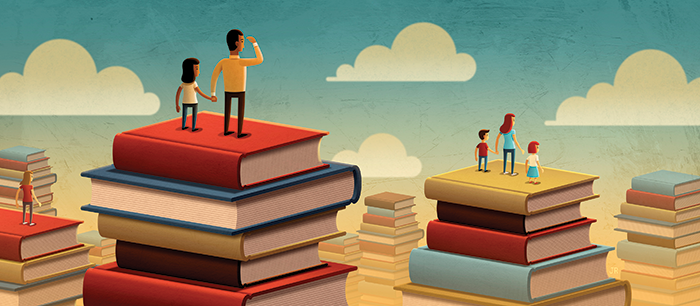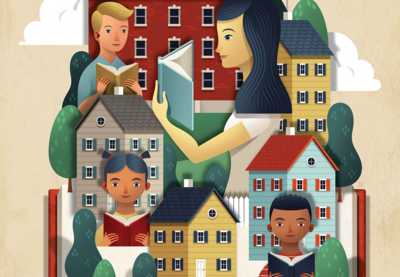Ten-year-old Siena Scornavacco stands on a chair overlooking a roomful of her peers and their parents, confidently laying out the evening’s agenda. Scattered around the room on couches and chairs are nine children ranging in age from 8 to 13 and a dozen adults. Seated next to Siena, her mom, Karla, offers a few helpful prompts and points of clarity—but she is careful to let her daughter do most of the talking. The mother-daughter team is co-leading tonight’s social justice book club. The topic Siena chose is a big one: the rights of children and how kids can fight against unfairness.
Everyone at the meeting has read two pre-selected and thematically relevant books, one on the civil rights movement and another on the Holocaust. Karla holds up a copy of The Tree in the Courtyard: Looking Through Anne Frank’s Window and confesses that she almost didn’t finish reading it with her two daughters, 10 and 8, because of the heavy subject matter. But tackling tough subjects is what this group is all about.
“When we’re talking about these things, we’re allowed to say what our feelings are,” Karla explains. “A part of our activism is to have that emotional awareness.” She pauses, then adds with a smile, “But we’re allowed to have fun.”
Taking her cue, Siena kicks things off with a lively game of Two Truths and a Lie. The group breaks up into smaller clusters of kids and adults who come up with three statements about any of the historical characters from their readings. Siena flits around the room, checking in on each group’s progress and offering encouragement, clearly enjoying her turn as the leader. Throughout the room, the kids laugh, debate and whoop in celebration at correct answers. No one scolds or tries to manage them. The vibe is more kid-run social gathering than classroom, with the adults hanging back and offering just enough helpful nudging to keep the ship on course.
It helps that this particular ship boasts an expert crew. Every adult in this room, located on the top floor of the education building at the University of Colorado Boulder, is a faculty or staff member here whose work addresses issues of justice and equity. And these are their children. But if that makes it seem like this is some staged experiment on multigenerational book clubs, that was never the intent. Yes, data is being collected. But any contribution to academia is secondary. These families came together for a more immediate purpose: responding to a new political climate that poses a direct threat to their values.
The New Normal
“I don’t think we would have done this if it hadn’t been for the [2016 presidential] election,” says reading group co-founder Kevin Welner, a CU professor of education and director of the National Educational Policy Center. “A lot of people said, ‘If Trump wins, I’m going to move to Canada,’ ‘I can’t raise my children in this environment,’ and that sort of thing. I think that for us, it was a similar sentiment. We were concerned about what the children would see as normal, lessons they would learn about how we treat the most vulnerable in our communities, what’s appropriate in terms of public discourse.”
Welner, along with his colleague Michelle Renée Valladares, decided to be proactive. They contacted other parents in the School of Education who had similar concerns and children around the same age as theirs and decided to put the current political climate in context. “We wanted our children to look at the current situation and understand that the struggle for social justice, the struggle for civil rights, is something that’s been going on forever and will continue to go on,” Welner says. “The current moment is best understood within that continuum, within that past and the need to continue the struggle into the future.”
Since the 2016 election, the group has met roughly once a month to discuss how contemporary views on race, identity, equality and belonging relate to the historical parallels in their readings. Their subjects run the gamut of social justice historical literature: the Lost Boys of Sudan, the internment of Japanese Americans during World War II, the civil rights movement, women’s suffrage and more. To keep the reading material fresh, they work closely with the CU library’s subject liaison for education, Lindsay Roberts, sending them a steady stream of title requests, which they eagerly accommodate.
“What’s been really cool is seeing this sort of creative energy and ideas that children and families have had of new materials that they suggest,” Roberts says, estimating that they’ve bought over two dozen new titles for the library so far based on the group’s suggestions. “They are definitely books that we wouldn’t necessarily have purchased otherwise.”
This idea not only creates community in the school and among our families; it creates a sense of possibility and critical action.
This influx of new material has prompted Roberts to carve out a prominent section of library space devoted to social justice literature for children, stocked with reading group books and other materials. Those materials are available to local K–12 students and teachers as well, which Roberts hopes will help connect the broader community to what they’re doing on campus. “What I would love to do more of is closer collaboration with our local school librarians and public librarians to close the loop here and see more sharing of social justice resources and ideas,” they say. “That’s my hope.”
Professor of Education Kathy Schultz, who also serves as the school’s dean, sees tremendous potential in this reading-group model. “This kind of idea not only creates community in the school and among our families; it creates a sense of possibility and critical action,” Schultz says, “which I think is very connected to what education is all about.” As a career educator and as a parent, Schultz says she’s encountered plenty of book clubs among adults and even “a few fun, novel ones” among adults and children. But nothing quite like this. “The fact that this is a group of parents who are coming together with their children to explore—in a variety of modalities—how to respond to the moment that we’re living in ... feels very unique to me, and [it’s] something I hope will catch on.”
There’s no reason it shouldn’t. The Boulder group’s situation is certainly unique in a number of ways, mainly in its demographics and access to resources. But it’s only one of many possible variations of the reading group model, one these participants have adapted to fit their specific needs. “Like any curriculum or any educational reform effort or any sort of teaching effort, it should be context-flexible,” Kevin Welner explains. Other unique examples of these reading groups have sprung up in diverse pockets around the country in states such as Texas, South Carolina and Michigan.

We’re Social Learners
In the Boulder group, the kids choose the topics and the structure, which usually involves a mix of games, discussions and group activities. The variety helps them stay interested and retain more, and the group setting strengthens their appreciation for the basic tenets of community, democracy and the power of their individual and collective voices.
The merits of bringing children, parents and educators together in this way are unassailable. Countless studies have demonstrated the clear benefits of family involvement in children’s reading—from improving early literacy and critical-reading skills to boosting social emotional learning. When that’s done in tandem with educators and reinforced regularly in a social setting, it creates a powerful incentive to learn and fosters a greater sense of community and shared goals.
“We’re social learners,” Welner explains. “We also learn when we’re more engaged. And if you think about the reading itself, it takes on meaning when you know you’re going to go into that environment and share your thoughts afterwards. A lot of what would otherwise maybe not be very compelling reading becomes compelling because of the context we’ve created.”
“This social action group was not connected to Black Lives Matter or the current response to the shootings in Florida that have activated youth,” Kathy Schultz says. “[But] they’re all borne out of youth desire to make a difference in the world in these times. I think it’s part of a larger, really global, youth movement.”
Start your own social justice reading group! Our new guide offers multiple models so you can work with families to design a group tailored to your school community.
Children on the March
The meeting Siena is leading takes place just days after the nationwide school walkouts against gun violence in the wake of the Parkland school shooting in Florida. Everyone in attendance either participated or had friends or siblings who did. To put this bold response by America’s youth into historical perspective, the group is watching The Children’s March, a documentary about the coordinated school walkouts against segregation that took place in Birmingham, Alabama, in 1963.
A lively discussion ensues, again with the kids drawing their own connections to contemporary examples. Siena says that although her school didn’t participate in this walkout, they are planning one against fracking.
“What’s fracking?” someone asks. Siena eagerly educates the group on the issue, one she’s proud to say has landed her on TV once and in the newspaper twice. Ten-year-old Alana Valladares immediately ties the environmental threat posed by fracking wells to something she read about oil pollution decimating sea turtle populations. Another student breaks in to talk excitedly about a solar-powered car some people in town are building.
And the conversation continues like this—kid-powered, parent-approved.
The group has been successful from a strictly educational standpoint by encouraging kids to take an active role in their own and each other’s education. But it has also served to strengthen bonds between children and their families in a way that may not be as easily measurable but is no less critical.
“I’ll pick Siena up from school, and as we’re driving here she’ll say, ‘Let’s do this again next year,’” says Karla Scornavacco. “She’s like, ‘This is one time a month that we get to do a mommy-daughter thing.’ And so that’s a special thing. To me, that’s beyond raising a little activist; it’s the time that we have together. That’s probably the most motivating thing—and that’s what hits you down at your heart.”
Constantin is the editorial coordinator for the Pennsylvania State Education Association.
